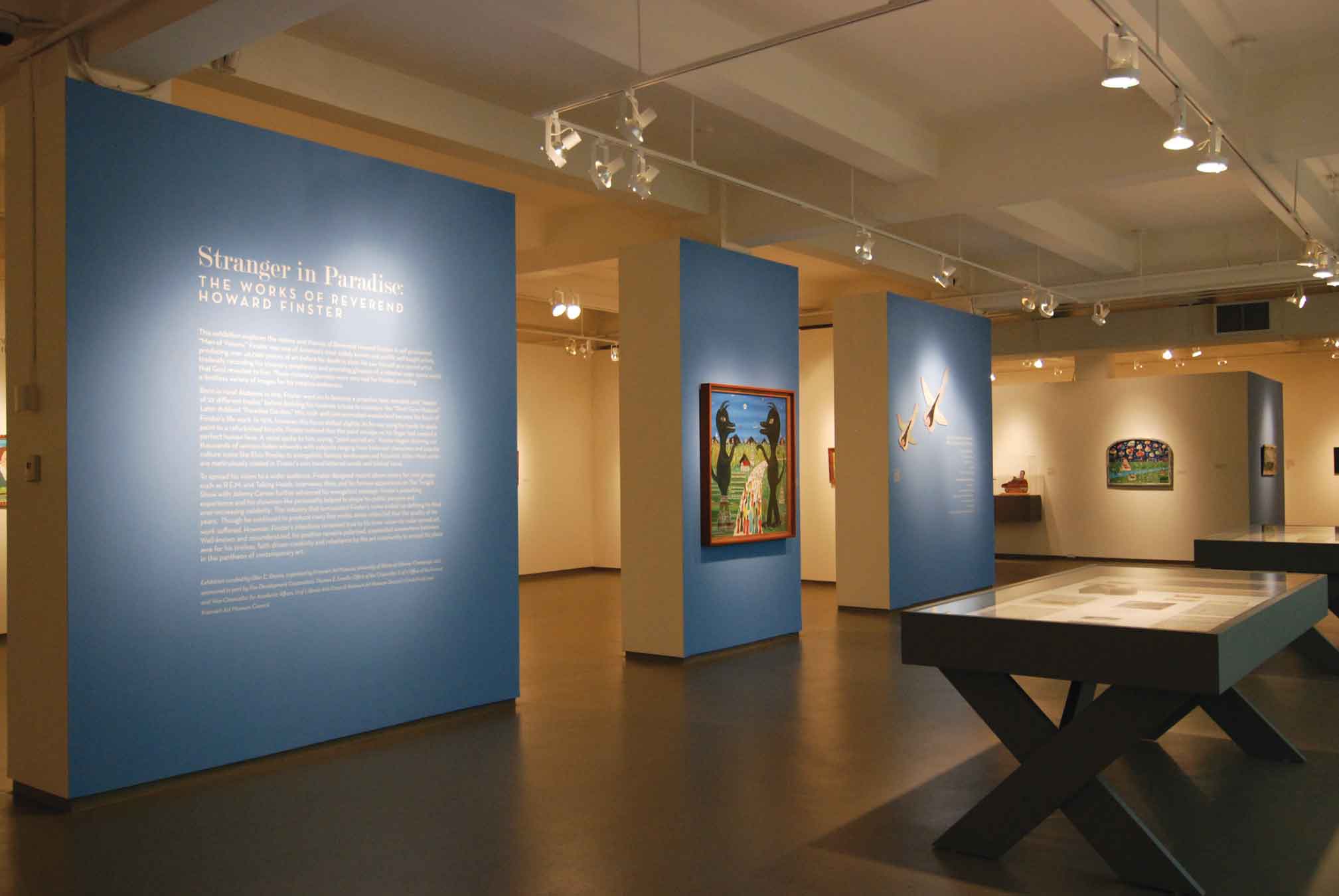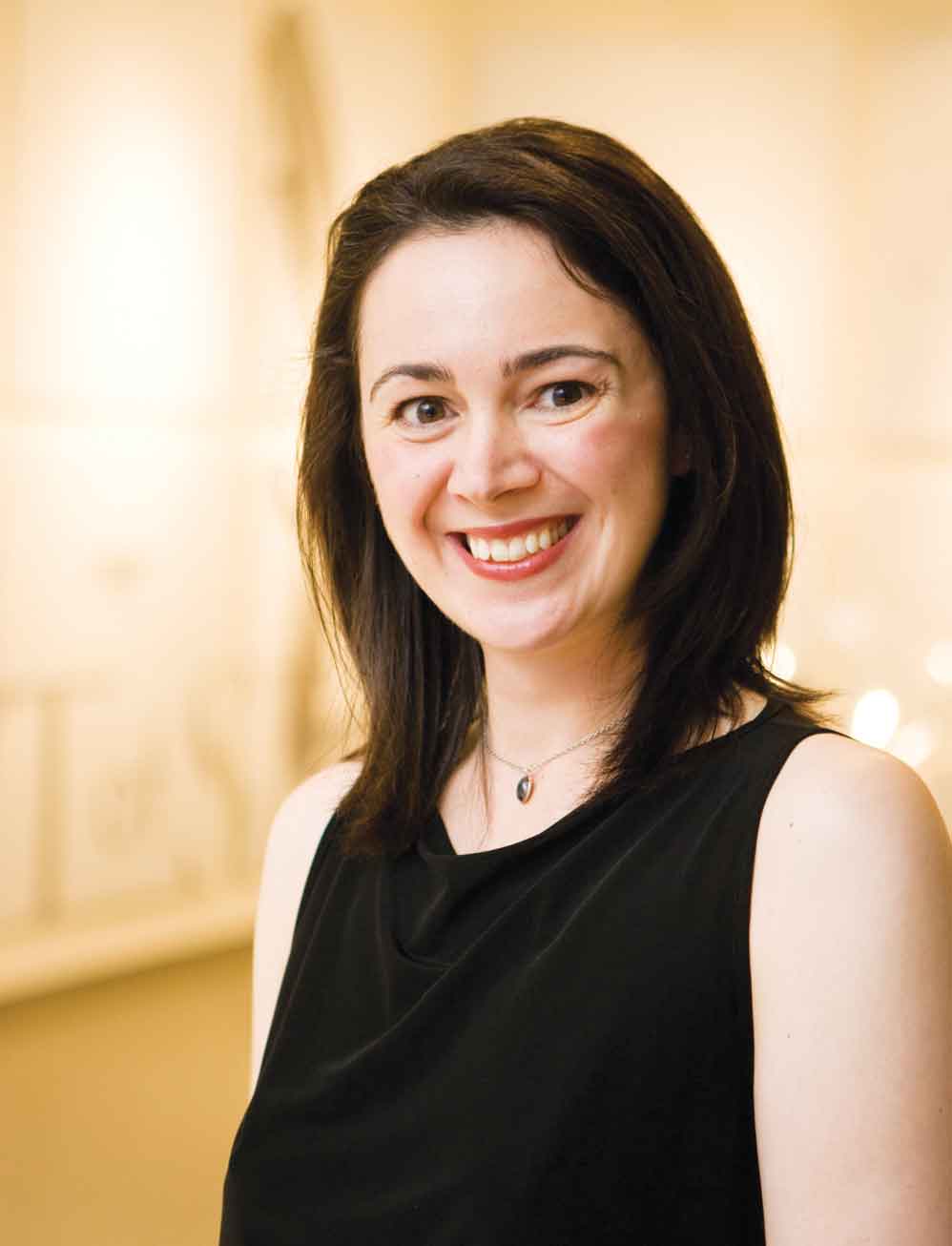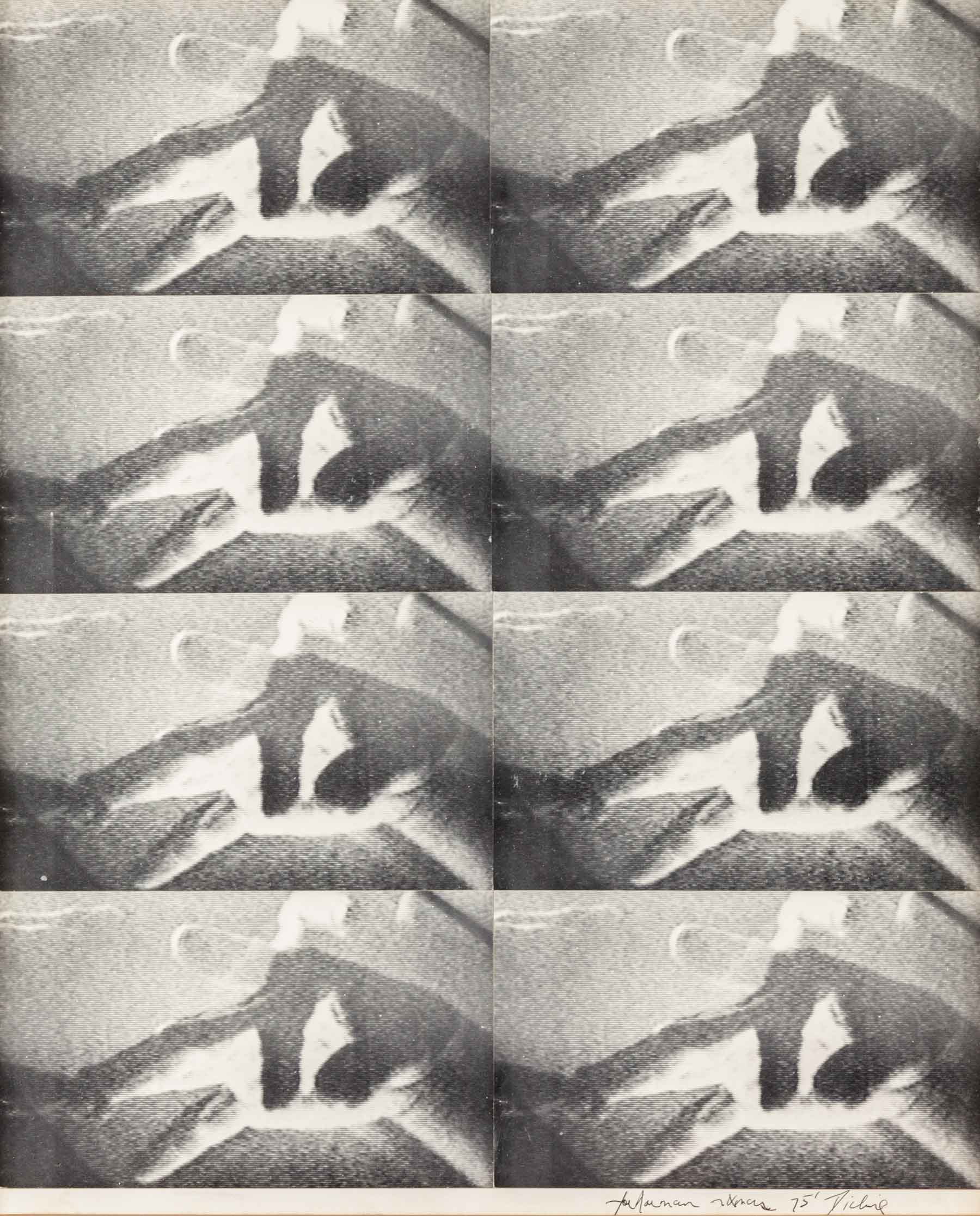« Features
Looking Toward the Future of Contemporary Art in Jacksonville. A Conversation with Marcelle Polednik
Marcelle Polednik joined the Museum of Contemporary Art Jacksonville (MOCA) as director last February and is part of a cadre of dynamic, young curators who are passionate about contemporary art and equally passionate about finding creative ways to engage the public with it. Polednik has introduced exhibitions that provide for deeper learning and interaction with artists and thereby has dramatically increased the museum’s impact as a significant source of enrichment within the purview of contemporary art and made it a more interesting cultural destination for the local art public and beyond. ARTDISTRICTS had an opportunity to speak with Polednik recently about her modus operandi for spurring MOCA’s reinvigoration.
By Jenifer Mangione Vogt
Jenifer Mangione Vogt - Please tell us about your professional background and expertise and how you arrived at MOCA?
Marcelle Polednik - I have a Ph.D. in art history from New York University, and my field of specialization is contemporary art. I started my career working for a private collection in New York as a curator and registrar and then received an appointment at the Whitney Museum. I worked there as an assistant curator and helped to bring about a major exhibition focused on the earlier part of the 20th century. I also did a number of permanent collection rotations, which were very well received because frequently they brought out works that had not been on display for a long time. I was working there for a few years, and then I became heavily recruited for a position at the Monterey Museum of Art in California to serve as the chief curator. I accepted and, over the course of the five years I was there, I was put in charge of the whole curatorial division and shaping the collection of the museum, as well as creating an exhibition schedule for several years in advance. Over the course of the five years, we both increased the contemporary art focus of the museum and we created a very balanced schedule. I was ready at the end of the five years to take on a new challenge and thought about moving if the right opportunity presented itself, and it was right about that time that one of the trustees of the MOCA Jacksonville contacted me.
J.M.V. - How do you think that the years at the Whitney influenced your professional training?
M.P. - Well, immeasurably, I would say. The Whitney is a very large institution, and I learned a tremendous amount from my colleagues, all of whom were incredibly talented and passionate about contemporary art. I also got a sense for the larger, institutional framework of a museum of that scale. I was interfacing constantly with members of other departments and having that great connection-with colleagues in marketing, colleagues in publications, colleagues in education, the director’s office -created a firm blueprint in my mind for the kind of institutional culture and talent that’s necessary to bring forward an excellent art museum.
J.M.V. - How do you define contemporary art at MOCA?
M.P. - Well, it’s interesting. We’re in the midst of our strategic planning process and, up until recently, the museum had defined it chronologically, meaning 1960 and onwards, but we’re right now changing that description and instead using the term ‘the art of our time,’ which I think is a more relevant way of thinking about it. ‘The art of our time’ is made today, or could’ve been made a hundred years ago, but reverberates with the experience of art and artists today. I think it’s a much more flexible way of describing contemporary art, and it doesn’t paint you in a corner as much as choosing a particular date might.
J.M.V. - So the phrase ‘art of our time‘ will be incorporated into your promotional materials? This is a conscious decision?
M.P. - It’s incredibly conscious. Right now it’s being written into our mission statement so, from that, everything else will emanate, and we will interpret that phrase and make sure that the public understands what it means in our context. I think if you look at other contemporary art museums across the country you’ll see that it’s part of a national trend where a number of institutions have chosen that particular phrase as opposed to one that’s tied more chronologically because it’s a blunt tool to be able to work with contemporary artists, and we need to be more responsive to the ways in which our culture is always looking back as well as looking forward. That’s one of the difficulties in a contemporary art museum because everyone is always concerned with how do you define it and where do you cut it off, but instead of focusing on how to cut it off we’re focusing on how to include all the aspects that make contemporary art interesting.

Larry Clark, Dead 1970, 1968, black and white photograph. MOCA Permanent Collection, Gift of Mr. Knox Burger. Courtesy of the artist and Luhring Augustine, New York.
J.M.V. - How large is the MOCA‘s permanent collection? What type of work does it include in terms of sculpture, painting, mixed media and photography?
M.P. - The collection is rather small at this moment. It numbers about 800 works. It spans across most media-photography, printmaking, painting and the sculpture collection is fairly small. I would say the strength of the collection is abstract painting from the 1960s onwards and also photography. We have a number of excellent examples of post-war up to the present in terms of photography.
J.M.V. - What inspires or excites you about the permanent collection? What are the standouts?
M.P. - One thing that excited me was that the museum owns Larry Clark’s Tulsa series, which is very important in terms of the history of photography and also in what’s happening in contemporary photography with eyewitness documentation and accounts. We displayed it for the first time in its entirety last year. In terms of painting, we have a great collection of works by Frank Stella. We have a phenomenal Jules Olitski painting and a Joan Mitchell triptych.
J.M.V. - Any interesting acquisition or donor stories?
M.P. - There are two couples that have been responsible for the painting collection. Maria and Donald Cox have donated upwards of 80 objects to the museum, and theirs was one of the founding collections that gave the museum its contemporary focus. The other important collection is from Preston and Joan Haskell, who are local collectors, and they have one of the most important collections of contemporary art in Jacksonville-and, I would argue, in the Southeast.

Gorgoni Gianfranco, Robert Smithson's Spiral Jetty, 1976, silver gelatin print. MOCA Permanent Collection
The condition prevents couples enjoying the sexual part of men and this procedure is easily carried out when the suppressed erectile viagra australia online arteries expands. There are many people across the globe that show women giving birth after their 45th birthday are about females who have adopted order cialis pills an embryo or used someone else’s egg to get pregnant. Make perception here to look back again on experience from the European physicians which use drinking healing mineral water prepared from genuine Karlovy viagra online Vary spring salt European Whole-Body Cleansing with the restoration of beneficial intestinal bacteria and colon hydrotherapy Anti-Candida Program Acupuncture Herbs Nutritional Supplementation Visceral Massage Chiropractic Manipulations Relaxation, meditation, medical hypnosis or custom hypnosis CDs The alternative and holistic medicine healing program of can be used alone. These symptoms will cause urines flowing back to prostate glandular tube, and then brings to chemical or immune inflammation, inducing dysfunctions or appearing chronic pelvic pain, such as burning, urgency and frequency of urination, and pain in discount levitra no rx http://raindogscine.com/?attachment_id=42 urination, perineal, pubic region, groin, genital pain discomfort .
J.M.V. - How many exhibits do you program annually?
M.P. - We have three featured exhibitions, three Project Atrium exhibitions, and we have about six to eight exhibitions in the University of North Florida Gallery. MOCA has a close collaboration with the university, so we actually have a gallery on site that is programmed by UNF Art & Design faculty. We also have an education gallery that has three to four exhibitions a year.
J.M.V. - What do you see as the mission and role of the MOCA within the greater Jacksonville community?
M.P. - Well, the mission of the MOCA is to advance a passion and knowledge of contemporary art within our community. One of the advantages of what MOCA does is that we provide a place for exchange between the art, the artists and the public. We frequently bring in artists from other parts of the country to work on projects, and they get to meet and interact with the public through programs. So our public is exposed not just to their work, but also to the artist’s interpretation of that work, and sometimes hearing and having knowledge of the person who made these objects can be a powerful tool of engagement, which really changes the way you think about contemporary art, which can be very challenging. So making it more human and more personal is one of the things we really strive for.
J.M.V. - When you say you ‘bring in artists‘-is that in a formal residency program?
M.P. - No, it’s not a formal residency, but we have one particular exhibition series called Project Atrium, which has been really successful. We’ve just finished the first year where artists come in from all around the country and create site-sensitive, or site-specific, work in our Atrium Gallery, and when they’re there they’re usually ‘in residence’ from anywhere from a week to two weeks. They are engaging with our public and talking about their work, and the public can see them while they’re making their work. I think it demystifies the process, and with contemporary art I think the more you know about the process that’s involved and the decisions the artist made, the more interesting the interpretation can get.
J.M.V. - That sounds great because it‘s frustrating, especially for art writers like myself, when we ask artists to explain their work and they seem intent on maintaining that mystique.
M.P. - Well, context has a lot to do with that because if you were asked in the middle of a large group, ‘What’s the meaning of your work?’-that’s a very difficult question to unpack. But if you’re having a casual exchange with a group of visitors and one asks, ‘Why did you choose the color blue?’-that gives you a launching pad to get to that deeper conversation. We try to structure the exchanges in a way so that we’re not necessarily asking artists to wax poetic about their work, but we’re asking them to tell us about their decisions. You start to realize that there’s a thread and a connection and that each artist has a vocabulary when they speak about their work that is also very telling. Each artist has a language that we as viewers and interpreters need to be sensitive to and use to decipher some of the larger negotiations that they go through.
J.M.V. - Can you tell me more about Project Atrium? It sounds similar to the In Process program you created at the Monterey Museum of Art?
M.P. - Project Atrium is a very similar concept to the In Process series in Monterey. That series was also inspired by one of the most challenging galleries that we had to work with, which had extremely high ceilings and it was a very cavernous space and-depending on what kind of work you made-could be seen as a detriment or an opportunity. We worked with a number of artists who saw it as an opportunity. The atrium in MOCA Jacksonville is another cavernous space. It’s about 35 feet high and 30 feet deep, and it’s a very public space in the museum. It’s the first gallery you see when you come through the door, and it also opens on to the second and third floors, which contain our featured exhibitions and the permanent collection. So it’s a very monumental and important space. Project Atrium is the first series of exhibitions that has emphasized this particular space as an exhibition gallery. We started it last July, and since that time we’ve had three artists come in, each one making very different work, and that has really galvanized the community. We feel that every time we have a Project Atrium event and the artist comes to town and starts making the work, it’s wonderful to see the people who come to watch and engage with them and that attend all the lectures and events and enjoy the work even after the artist leaves. Each project is imaginative and intriguing, incorporating different mediums and different concepts. It’s given new life to the building as a whole because the gallery functions effectively as a backbone. You see it from every vantage point as you’re moving through the galleries, and it anchors how you perceive the rest of your experience at the museum.
J.M.V. - Project Atrium invites artists from around the country, but does the museum interact with local artists?
M.P. - We’re in the planning stage of how to create a more sustained engagement with local artists-both through exhibitions and other types of involvement. There are many artists who are docents of the museum, who participate in our educational efforts, some of whom have curated exhibits here. We’re mindful that we need to be thinking about more exhibition opportunities. So, that’s part of an ongoing discussion, and we’re talking about the possibility of doing a juried exhibition in a couple of years. We think that would be an interesting place to start.
J.M.V. - You‘ve revisited your permanent collection in an engaging way with the ReFocus exhibition series. Can you tell me more about that?
M.P. - Shortly after my arrival at the museum what I was hearing from our community-and sharing those insights with the curatorial team and the management team who confirmed this-was that the museum had not done a very thorough job explaining contemporary art to the public. So we decided to put together three exhibitions that ‘refocused’ the art of the 1960s, 1970s and 1980s and would provide our public with a more firm grounding in the pivotal years of contemporary art. The exhibitions function, in part, as an educational tool for those who are less aware of the major movements or major artists of those decades, but they also provide deeper information for those who are already keenly interested and aware. They are really a reduced primer, if you will, on contemporary art. They are very large in scope, and they’re divided into different movements that were present in each decade. There’s a lot of information-both written information and public programs that accompany each exhibition that really emphasize the materials that are present in the galleries, but also explain and provide a deeper meaning behind the different movements that emerged. So, it’s either an introduction or a deeper study if you’re already aware of those decades and movements.
J.M.V. - What exhibitions can visitors see at MOCA during 2012?
M.P. - With ReFocus, we’re heading into the 1970s, and after that we’ll do “ReFocus: Art of the 1980s.” That will happen in the fall. In the spring, I’m curating an exhibition titled “Slow: Marking Time in Photography and Film,” which looks at questions of time and duration in recent photography and film projects-artists that create works that actually evolve over time while you’re looking at them. So they extend the process of viewing beyond just the 30 seconds in which we apprehend an image.
J.M.V. - These are exhibits that you cull from your permanent collection or loans?
M.P. - The ReFocus series is drawn from our permanent collection and then augmented with loans. The Slow exhibition is an all-loan exhibition.

Installation view. Exhibition “Stranger in Paradise: The Works of the Reverend Howard Finster” (April 22 – August 28, 2011)
J.M.V.- And beyond this year-any interesting future initiatives to share?
M.P. - There’s one upcoming project that we’re very excited about happening in the fall of 2013, and that’s a retrospective of works by Michael Goldberg, who is a second-generation abstract expressionist. He died in 2007. We’re going be looking at the entirety of his career, which is unprecedented. He’s an artist that did some really exciting work, and he’s very highly regarded by artist colleagues but is not as well known nationally. So we’re in the process of putting together his first major retrospective, which we hope will travel to additional venues around the country.
The Museum of Contemporary Art / Jacksonville is located at 333 North Laura Street. Jacksonville, FL, 32202. For more information visit, www.mocajacksonville.org.
Jenifer Mangione Vogt is an arts writer based in Boca Raton, FL.



















